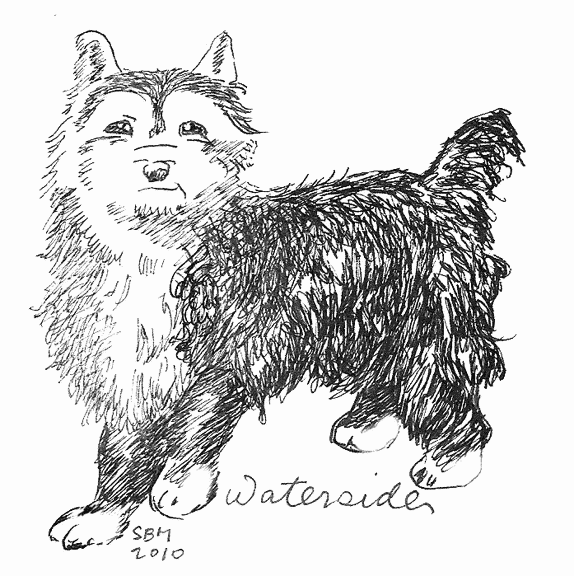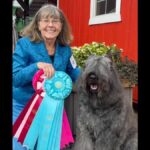Here is a thorough account of the Silky Terrier’s breed origins. It all starts with the Yorkie, and even before that.
Yorkie Beginnings
Although it may seem to some that the Yorkshire Terrier sprang ready-made to life, he was in fact developed from the clever weaving of several now extinct breeds in the late 18th and 19th centuries. But the origins of these breeds, and therefore the Yorkie as well, goes back much farther than that.
Many hundreds of years ago, most people in England were called serfs and were tied to the land. They were prohibited by law to move. Furthermore, each child was required to take on the same job as their parents. If Dad was a farmer, so were they. They were not allowed to hunt, nor keep most hunting dogs. As far back as the Canons of Canute (an English king who died in 1035; he set up many laws or “canons”) these common people were allowed “the little dogs” because “it stands to reason that there is no danger in them.”
The foresters had a hoop and only the dogs that could pass through the 7-inch diameter could be kept. The little dogs kept home and hearth free of rats and other vermin, as well as providing an occasional rabbit for the pot. They were bred generation after generation to be fearless and independent hunters. As their owners were bound to the land, prohibited from moving away by a system that demanded not only lifelong servitude to a distant master but also that their children and children’s children do the same, their dogs did not move around much either.
Gene pools were kept small with neighborhood dogs breeding together and each valley tended to have its own version.
So it began. Each region had its own variety of little dog, but all needed to be quick-thinking and independent, as their hard-working owners did not have the time to cosset them. They needed to be loyal, as their owners wanted a dog that protected the meager family interests, and cheerful. The common people lived lives strewn with hard knocks — they needed dogs that were sprightly and optimistic.
Though some conjecture is inevitable, original accounts exist to cover the broad strokes of how Yorkshire Terriers seemingly came “from nowhere” to exist as the unique and distinctive breed they are today. Three breeds – all extinct today – each contributed their unique characteristics.
The Waterside Terrier
By the time of William IV (1765–1837), the Waterside Terrier, sometimes blue and tan in color, was common in Yorkshire. Slightly longer than tall, with a level topline and an erect or semi erect ear, he resembled a Welsh Terrier – but much smaller, between 5 and 10 lbs. Prized for his loyalty and independent hunting abilities, he was “broken-coated”, which means he had a medium length coat similar to today’s Cairn Terrier. A famous Waterside named Polly weighed 6 lbs. She had 5 inches of body coat and silver furnishings. She wasn’t afraid of water and would swim the river and hunt with the ferret.

News of the Waterside also came from Tasmania in Australia, where settlers prized the small blue and tan dogs for their ability to detect strangers approaching from great distances.
The Paisley and his close cousin, the Clydesdale Terrier, originated in Scotland. All of these dogs had a fierce and loyal disposition. But to start, their mutual ancestor needs to be mentioned.
The Skye Terrier
The Skye, originating and named after the Isle of Skye in Scotland, was a unique breed as early as the 1500s. Sweeping long low bodies and swishing coats behind milady through the dank stone corridors of British castles, Skyes were a favorite of the nobility, even the ill-fated Mary Queen of Scots. A Skye Terrier kept Mary company all the years of her long imprisonment. But Skyes were also true terriers, fiercely loyal and independent hunters, with courage unmatched in dogdom. They had a hard, nylony, floor-length coat with a definite undercoat, and an erect or semi-erect ear.
The Paisley and Clydesdale Terriers
In the late 18th century, several Skye breeders tried to miniaturize their breed. Speculation can imagine heated letters moving back and forth and drawing rooms echoing with voices raised in loud argument, but the purists of the day won out. No way could these smaller dogs be called Skyes. Denied recognition by the parent club, the “mini Skyes” were called Paisleys or Clydesdale Terriers, named presumably after those valleys in Scotland.

They resembled Skyes, being long and low, but instead of the bigger dog’s vigorous 40 to 50 lb proportions were about 15 lbs. in weight. They also had a much softer and finer than the Skye’s and had the gloss factor which makes a Yorkshire’s coat reflective like blue burnished steel. The Paisley was blue and “self” colored, which means one single color, while the Clydesdale had what writers of the day called a “linty” coat – tan or flax furnishings together with a blue body coat.
So there are the three elements; the blue and tan, broken coated, slightly longer than tall Waterside, the short legged, blue, long-coated, glossy Paisley and the identical Clydesdale with golden tan, “linty” furnishings. Unique elements came from all three but they had one thing in common; they were all independent, cheerful, feisty and loyal.
The Industrial Revolution
Another event in the creation of the Yorkshire Terrier occurred in the late 18th century— the Industrial Revolution, which began in northern England. The newly established factories and foundries quickly developed an insatiable appetite for workers. Scottish weavers and other workers flocked south, bringing along their families, and of course, their dogs.
The workers, streaming out from their backbreaking and monotonous jobs, longed for a pint and a “tickle” (a wager on something, anything to take them away from their drab surroundings) at their favorite pub. They loved to wager on how long it would take for a big dog to bring down a bull or a bear. But in 1825, bear- and bull-baiting was outlawed. So now what? The publicans were desperate for something new to entice customers.
Eureka! A small dog was thrown into a pit with 30 or 40 rats. It wasn’t a matter of whether dog or rat would win—it was a matter of how fast the dog could dispatch all of the rodents. The smaller the dog, the more audacious the contest and the better the betting. Favorite breeds must have been the scrappy and tenacious Paisleys, Clydesdales, and Watersides. Polly, the Waterside mentioned above, was famous for her ability to dispatch rats in a pit.
The pub owners, in their search for ever smaller, ever hardier dogs, liberally wove the three breeds together. So the hands that began the creation of the elegant sprite we know today as the Yorkshire Terrier were gnarled and working class. They bred their dogs smaller to earn more money, and they bred them tough as nails.
Silky Terrier Breed Origins – What Happened at the Dog Show
As the three breeds were woven together, something interesting occurred. Genes from the glossy, long-coated Clydesdale and Paisely and the short-backed Waterside occasionally combined to create small, short-backed puppies with straight, shiny blue and tan coats. How lovely! And as the publicans sat back and admired their creations, they had an idea. Why not create even more pub business by putting on dog shows? So as early as 1849, the British public was introduced to the little dogs at shows.
It was love at first sight.
Silky Terrier Breed Origins – Influence of Huddersfield Ben
The father of the Yorkshire Terrier was a dog named Huddersfield Ben, born in 1865. He was owned by Mrs. Jonas Foster, who set the early fashion in Yorkies. Ben is the first dog to be recorded as a Yorkshire Terrier. Mrs. Foster entered Ben in a number of dog shows, winning 74 prizes along the way.
So what’s the deal with Silkys? Guess what. We have records of Hudderfield’s Ben grandmother Katie emigrating to Tasmania, Australia. You better believe that if we know about Katie, there were lots of other little blue and tan terriers making the long voyage as well.

Silky Terrier Breed Origins
KATIE (and her unsung relatives) are the progenitors of the Silky Terrier. A newspaper article shared by Jan Broadby Klaus described her gread great grandfather John Gillon’s masonry business in Hobort 1860 – 1880. In the forefront of the newspaper picture is a Silky Terrier.
Silkys were bred in Tasmania to be snake hunters and house watchdogs. This was while Yorkies were being bred to be dainty companion dogs in Northern England. So, you can imagine that different attributes in the very different areas were valued!
Were other breeds mixed with Kate and the others that emigrated? Undoubtedly. But the basic genetics of the Yorkie and the Silky remained the same. It certainly was not the same as “a Yorkie was bred to a …..”
Nope. The Silky and the Yorkie were developed simultaneously.
For this we can thank Katie and her cousins, all their scrappy terrier forebears, and a Danish King who wanted to make sure that commoners couldn’t own big dogs.
Silky Terrier Breed Origins – Showsight Magazine December 2020 Issue
Featured photo courtesy by the American Kennel Club.
Are you looking for a Silky Terrier puppy?
The best way to ensure a long and happy relationship with a purebred dog is to purchase one from a responsible breeder. Not sure where to begin finding a breeder? Contact the National Parent Club’s Breeder Referral person, which you can find on the AKC Breeder Referral Contacts page.
Want to help rescue and re-home a Silky Terrier dog?
Did you know nearly every recognized AKC purebred has a dedicated rescue group? Find your new best friend on the AKC Rescue Network Listing.
Silky Terrier Dog Breed Magazine
Showsight Magazine is the only publication to offer dedicated Digital Breed Magazines for ALL recognized AKC Breeds.
Read and learn more about the friendly Silky Terrier dog breed with articles and information in our Silky Terrier Dog Breed Magazine.
Error embedding FlippingBook shortcode, please check the flipbook url. (https://digital.showsightmagazine.com/view/521812/)













